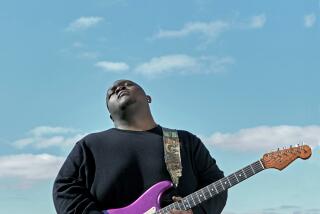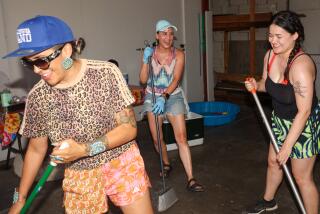Birth of the Blues : West Hollywood: Three times a week, the nightspot becomes a classroom and museum. It helps trace the lineage between African and American culture.
On a softly lit nightclub stage, backed by a rhythm guitar, bass and drums playing a driving blues riff, Adriane Michel grasped a microphone in her two small hands and belted out the âSchoolgirl Blues.â
âWoke up this morning, and I didnât know what to do
So I decided to sing the blues
Then I called my friends
But they were out at the mall
and I didnât have any breakfast
so thatâs why Iâm singing the blues . . . â
The other fourth- and fifth-graders from Manhattan Elementary School in South Los Angeles clapped and laughed as Adriane, 9, and a few others shyly walked up to the microphone on the House of Blues stage. They told their tales of lost shoes, too much homework and fights with playmates--facts of life that give kids the blues.
Three times a week, House of Blues, the hot West Hollywood nightspot, becomes a classroom and museum. Storytellers, educators, musicians and art experts lead groups of students from Los Angeles Unified schools on a cultural history tour, using the clubâs African masks and contemporary folk art to trace the lineage between African and American culture.
In a matter of three hours, the students had been led back 300 years to West Africa, to learn that rites of passage and religious ceremony centered around the drum. Storytellers act out experiences of black slaves in the 18th- and 19th-Century American South, telling how slaves created an intricate communications network using work songs and spirituals.
All this, explained the musicians and educators, lay the foundation for a true American music form: the blues.
The educational program is run by the International House of Blues Foundation. Last year, the foundation held similar programs for students at House of Blues clubs in Cambridge, Mass., and New Orleans. Another will start next year in New York.
With arts and music programs disappearing in most public schools, programs like this are desperately needed, said Issac Tigrett, chief executive officer of House of Blues.
âItâs pretty extraordinary that entertainment is our biggest export, but no arts or music are being taught in the schools,â he said. The program on the blues, he added, âplant seeds, try to promote dignity. Most kids donât even know about the contributions African Americans have made over the years. So when they find out these men and women created this music and art, it really turns them on.â
During the program, students learn that the air-conditioner and the baby stroller were among many inventions created by African Americans.
The House of Blues Foundationâs board of directors developed the education program last year in Cambridge, Mass. The board includes educators from Harvard University, the Boston and Cambridge school systems, the Berklee School of Music and the University of Mississippi.
William Ferris, director of the Center for the Study of Southern Culture at the University of Mississippi, said that the absence of blues education in schools leaves children in the dark about an important chapter of American history.
âTraditionally, classical music was appropriate to teach to children, and we turned our backs on our own cultural heritage,â said Ferris, whose center houses the largest blues and Southern culture archives in the nation. Now, he said, âthe blues are no longer just the music of rural Southern blacks, but an American art form that has inspired and shaped everything from gospel to rock ânâ roll, and more recently, to rap.â
To further blues education in the schools, the University of Mississippi will hold a summer course co-sponsored by House of Blues to help selected Los Angeles teachers develop their own blues curriculum. The foundation will also award $4,000 college scholarships to four Los Angeles students next year.
At one of the recent classes, the students toured the House of Blues, then returned to the stage area. The curtain rose, and the band âBlack Coffee and Jam,â played an Elmore James tune called âDust My Broom.â
âDo you know what the blues are?â asked Sheldon Strickland, the bandâs front man.
âItâs old-time music,â volunteered one child, as the others giggled. Not true, explained Strickland. Then the band got the kids dancing when they played âLucilleâ by Little Richard and Jimi Hendrixâs âPurple Haze.â That music, he told the children, had its roots in the blues.
Lena Roberts, a parent of a fourth-grader, was wary of an education program sponsored by a blues club. âI expected to hear a lot of blues, but I didnât expect the teaching of culture,â she said.
Before she headed back for the bus, 9-year-old Felicia Francis said she had gained a new understanding of the blues. âWhen he was playing you could feel it in your heart,â she said. âIt felt like your heart was keeping the same beat.â
More to Read
The biggest entertainment stories
Get our big stories about Hollywood, film, television, music, arts, culture and more right in your inbox as soon as they publish.
You may occasionally receive promotional content from the Los Angeles Times.










